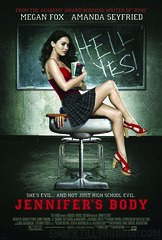The recent release of Jennifer’s Body may be an example of an emerging trend of women producing horror films, a typically male-dominated genre.

Friday, Sept. 18, many moviegoers were met with the premiere of Jennifer’s Body, a new horror movie with a predominately-female production crew. The crew, which includes writer of Juno Diablo Cody and director of Girlfight Karyn Kusama, created a horror movie to fit the new audience of these films, young women.
Recent high-grossing horror movies like The Ring and The Grudge all had predominantly female audiences, said Christine Spines in her article, “Horror Films…And the Women Who Love Them!” published July 31, 2009 in Entertainment Weekly.
“We’re also talking about all the slice-and-dice remakes and sequels that Hollywood churns out,” Spines said. Women have developed more of a stomach for blood and gore, a trend that Hollywood is enjoying at the moment.
“Hell is a teenage girl,” said Amanda Seyfried in the opening scene of Jennifer’s Body, which begins as a classic teenage-girl story.
Megan Fox plays Jennifer Check, the beautiful, popular head cheerleader, whose childhood best friend Needy Lesnicky, played by Amanda Seyfried, is the shy, quirky girl who stays under the radar. The two make an odd pair, but as Needy said in the second scene, “sandbox love never dies.”
After a tragic night out involving a bar fire and a satanic ritual gone wrong, the girls’ normal, high school lives are no more.
Jennifer, now more demonic than feminine, thrives on sex and human flesh as a Succubus, which is a mythical female demon who has her way with men by seducing them in their sleep.
While many horror movies concentrate on the “blood and guts,” this one focused on the story behind the carnage, and feminine touches by the writer and director had a place in the madness.
“It was more than just a scary movie, kind of like a ‘chick flick’ scary movie,” said Jamie Weiss, a café manager from Ambler, Pa.
Without the demonic cheerleader, the back-story might resemble the sentimentality of a Lifetime “made for television” movie.
“It’s really interesting how the demographics for horror films have clearly shifted,” said John Edward Campbell, assistant professor at Temple’s broadcasting, telecommunications and mass media department. “Now that the industry has noticed this … [it’s] finally making horror movies geared specifically to women.”
“The truth is that if you look beneath horror’s gory surface,” Spines’ article said, “you’ll often find a stealth empowerment message, thanks to some canny ingénue who claws her way out of danger.”
As social norms change, mass media and entertainment tend to follow. Today, women make up the majority of horror film audiences, probably because female roles in society have evolved so much, Campbell said.
Casting Megan Fox in the role of Jennifer, however, may have been a marketing tool geared towards a male audience.
“I don’t see guys enjoying it that much, other than the fact that Megan Fox is in it,” Weiss said.
Horror plotlines, though, still seem to resolve with one reigning female character evading all danger and living through the terror.
“Historically the sole survivor … always tended to be this kind of pure, chaste, virginal character. Women who had sex in horror movies always died,” Campbell said, adding that even in older horror movies where this sexual stigma thrived, audiences saw a strong female character that beat out the odds to survive.
“Media seems to be giving women permission to take control of their own sexuality.”
Laura Standley can be reached at laura.standley@temple.edu.



Be the first to comment